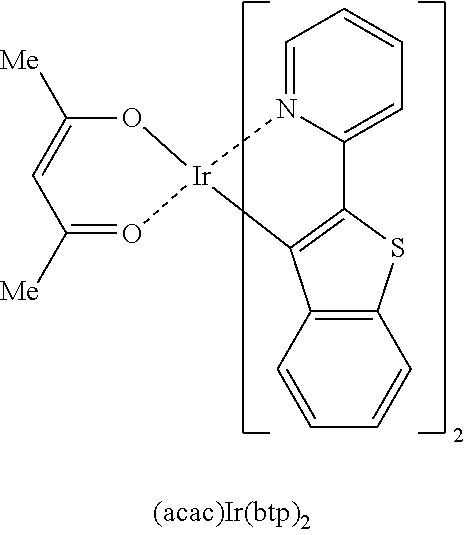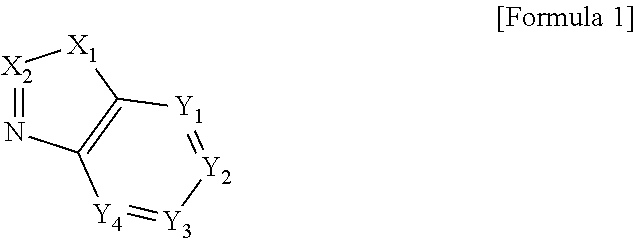Novel compound and electroluminescent device including same
a technology of organic electroluminescent devices and compound, which is applied in the direction of luminescent compositions, thermoelectric devices, organic chemistry, etc., can solve the problems of poor thermal stability and failure to reach a satisfactory lifespan, and achieve excellent heat resistance, enhanced hole transport layer, and/or light-emitting layer. large
- Summary
- Abstract
- Description
- Claims
- Application Information
AI Technical Summary
Benefits of technology
Problems solved by technology
Method used
Image
Examples
preparation example 2
Synthesis of Compounds Core2A and Core2B
Synthesis of 5-(2-nitrophenyl)-1H-benzo[d][1,2,3]triazole
[0091]
[0092]6.3 g (yield: 51%) of 5-(2-nitrophenyl)-1H-benzo[d][1,2,3]triazole was obtained by performing the same procedure as in of Preparation Example 1, except that 7.9 g of 5-chloro-1H-benzo[d][1,2,3]triazole was used instead of 5-bromo-1H-benzo[d]imidazole used in of Preparation Example 1.
[0093]1H-NMR: δ 7.68 (m, 2H), 7.92 (t, 1H), 8.03 (m, 3H), 8.20 (s, 1H)
Synthesis of Compounds Core2A and Core2B
[0094]
[0095]2.3 g (yield: 42%) of Compound Core2A and 0.8 g (yield: 14%) of Compound Core2B were obtained by performing the same procedure as in of Preparation Example 1, except that 6.3 g of 5-(2-nitrophenyl)-1H-benzo[d][1,2,3]triazole obtained in of Preparation Example 2 was used instead of 5-(2-nitrophenyl)-1H-benzo[d]imidazole used in of Preparation Example 1.
[0096]1H-NMR for Compound Core2A: δ 7.28 (t, 1H), 7.48 (m, 2H), 7.65 (d, 1H), 7.98 (d, 1H), 8.13 (d, 1H), 10.33 (s, 1H)
[0...
preparation example 3
Synthesis of Compounds Core3A and Core3B
Synthesis of 5-(2-nitrophenyl)benzo[d]oxazole
[0098]
[0099]4.1 g (yield: 46%) of 5-(2-nitrophenyl)benzo[d]oxazole was obtained by performing the same procedure as in of Preparation Example 1, except that 5.7 g of 5-chlorobenzo[d]oxazole was used instead of 5-bromo-1H-benzo[d]imidazole used in of Preparation Example 1.
[0100]1H-NMR: δ 7.65 (t, 1H), 7.88 (m, 4H), 8.12 (m, 3H)
Synthesis of Compounds Core3A and Core3B
[0101]
[0102]1.6 g (yield: 45%) of Compound Core3A and 0.4 g (yield: 14%) of Compound Core3B were obtained by performing the same procedure as in of Preparation Example 1, except that 4.1 g of 5-(2-nitrophenyl)benzo[d]oxazole obtained in of Preparation Example 3 was used instead of 5-(2-nitrophenyl)-1H-benzo[d]imidazole used in of Preparation Example 1.
[0103]1H-NMR for Compound Core3A: δ 7.02 (d, 1H), 7.28 (t, 1H), 7.53 (t, 1H), 7.72 (d, 1H), 7.98 (s, 1H), 8.15 (m, 2H), 10.38 (s, 1H)
[0104]1H-NMR for Compound Core3B: δ 7.30 (t, 1H), ...
preparation example 4
Synthesis of Compounds Core4A and Core4B
Synthesis of 6-(2-nitrophenyl)benzo[d]thiazole
[0105]
[0106]4.7 g (yield: 62%) of 6-(2-nitrophenyl)benzo[d]thiazole was obtained by performing the same procedure as in of Preparation Example 1, except that 6.3 g of 6-bromobenzo[d]thiazole was used instead of 5-bromo-1H-benzo[d]imidazole used in of Preparation Example 1.
[0107]1H-NMR: δ 7.72 (m, 2H), 7.92 (m, 3H), 8.35 (s, 1H), 9.28 (s, 1H)
Synthesis of Compounds Core4A and Core4B
[0108]
[0109]2.2 g (yield: 53%) of Compound Core4A and 0.9 g (yield: 21%) of Compound Core4B were obtained by performing the same procedure as in of Preparation Example 1, except that 4.7 g of 6-(2-nitrophenyl)benzo[d]thiazole obtained in of Preparation Example 4 was used instead of 5-(2-nitrophenyl)-1H-benzo[d]imidazole used in of Preparation Example 1.
[0110]1H-NMR for Compound Core4A: δ 7.25 (t, 1H), 7.55 (m, 3H), 7.78 (d, 1H), 8.15 (d, 1H), 9.26 (s, 1H), 10.27 (s, 1H)
[0111]1H-NMR for Compound Core4B: ≡ 7.26 (t, 1H...
PUM
| Property | Measurement | Unit |
|---|---|---|
| current density | aaaaa | aaaaa |
| organic | aaaaa | aaaaa |
| driving voltage | aaaaa | aaaaa |
Abstract
Description
Claims
Application Information
 Login to View More
Login to View More - R&D
- Intellectual Property
- Life Sciences
- Materials
- Tech Scout
- Unparalleled Data Quality
- Higher Quality Content
- 60% Fewer Hallucinations
Browse by: Latest US Patents, China's latest patents, Technical Efficacy Thesaurus, Application Domain, Technology Topic, Popular Technical Reports.
© 2025 PatSnap. All rights reserved.Legal|Privacy policy|Modern Slavery Act Transparency Statement|Sitemap|About US| Contact US: help@patsnap.com



